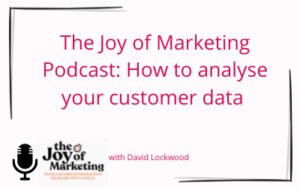In our last post, we talked about the implications of major players such as Apple, Mozilla, Microsoft, Amazon and Google switching off third-party cookies. With the help of data protection and marketing expert, Julia Porter from Data Protection Network, let’s now explore the steps brands can take to move beyond the cookie.
1.Build your own customer database
Not only does first-party data give you accurate (or deterministic) insight directly from those most likely to be interested in your brand, you can also be confident that you’ve obtained the relevant permissions to use their data, e.g. for marketing purposes. Customers who understand why their data is being collected are far more likely to allow you to use it. Building your own Customer Data Platform (CDP) can be daunting. However partnering with a specialised customer insight agency such as Tapestry can help remove both the technical and strategic burden of collating and segmenting your data.
2.Create the perfect pop-up
The best way of winning over customers is to be explicit about the benefits of sharing data. The ICO’s cookie guidance from 2019 is clear: anyone who hasn’t updated their cookie notices or privacy notices needs to do so. Therefore, when you’re drafting or updating your cookie alert, make sure you use easy-to-understand, jargon-free language. Similarly, don’t make your privacy policies or sign-up forms too complicated.
3.Supplement with pseudonymised data
Pseudonymised data refers to data from individual real-time user profiles which has been stitched together along the customer journey, but made anonymous so that no Personally Identifiable Information (PII) remains. By collaborating with a third party such as a marketing personalisation agency, or a data cooperative, brands gain access to “clean rooms” comprising millions of addressable yet pseudonymised customer profiles. They can then use this behavioural insight to enrich their own first-party data sets and push out much more relevant messaging.
4.Looking ahead to Contextual Advertising
In contrast to behavioural advertising (i.e. based on user behaviour), some advertisers and publishers are beginning to tap into initiatives such as the Ozone Project to focus on more contextual solutions. This involves tailoring advertising creatives towards the environment – or context – in which they appear. For brands who have already worked hard to segment their first-party database, creative optimisation (i.e. tailoring adverts according to context) is relatively straightforward.
5.Marketing on the ‘edge’
One of the latest technological developments is ‘edge computing’, where all of a user’s data remains on the device they are using to consume the brand’s content. This means the data doesn’t actually need to be moved or shared with any other party, while the brand gains a real-time snapshot of how their users are interacting with their content. As one of the most privacy-friendly ways of accessing data, edge computing is likely to be widely adopted over the coming years.
Whether you decide to ‘go it alone’ when building up your database, or opt for more collaborative solutions, it’s important to bear in mind that bodies such as the ICO will be looking to make sure companies are sharing permission-driven data within a safe environment. Therefore, if you opt for the latter, it’s advisable to carry out Data Privacy Impact Assessments (DPIAs) which demonstrate clear supplier due diligence when you’re procuring these services.
As we approach the end of the third-party era, the most important advice for all retailers is to understand the change that is coming, evaluate the data you already have, and determine how reliant you are on third-party cookies. From there you can work out what you need to do to enrich your data set and retain those all-important connections with your customers.




